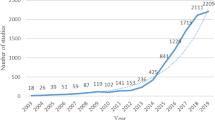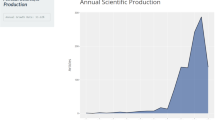Abstract
The smart university concept seeks to improve the quality of life by applying information technologies in a comprehensive, intensive, and sustainable way. It is an emerging concept, where little attention has been paid so far to the quantitative description of its evolution. The main objective of this article is to present the results of a bibliometric analysis around the emerging concept of smart university. It includes citation analysis, keyword networks, journal co-citation networks, references, and most cited authors. For this paper, a computer tool was used as a support to identify and visualize the intellectual structure of the smart university concept and its relationships retrieved from the Dimensions.ai. platform.
Access this chapter
Tax calculation will be finalised at checkout
Purchases are for personal use only
Similar content being viewed by others
References
Rico-Bautista, D. et al.: Smart University: a review from the educational and technological view of internet of things. In: Rocham, Á., Ferrás, C., Paredes, M. (eds.) International Conference on Information Technology and Systems, ICITS 2019, pp. 427–440. Springer Verlag, Systems and Informatics Department, Universidad Francisco de Paula Santander Ocaña, Algodonal Campus Vía Acolsure, Ocaña, 546551, Colombia (2019). https://doi.org/10.1007/978-3-030-11890-7_42
Rico-Bautista, D.W.: Conceptual framework for smart university. J. Phys. Conf. Ser. 1409, 012009 (2019). https://doi.org/10.1088/1742-6596/1409/1/012009
Sánchez-Torres, B. et al.: Smart campus: trends in cybersecurity and future development. Rev. Fac. Ing. 27(47), 93–101 (2018). https://doi.org/10.19053/01211129.v27.n47.2018.7807
Rico-Bautista, D. et al.: Smart University: big data adoption model. In: 2020 9th International Conference On Software Process Improvement (CIMPS), pp. 52–60. IEEE (2020). https://doi.org/10.1109/CIMPS52057.2020.9390151
Rico-Bautista, D. et al.: Smart University: key factors for an artificial intelligence adoption model. In: García, M.V. et al. (eds.) Advances and Applications in Computer Science, Electronics and Industrial Engineering, pp. 153–166. Springer Singapore, Singapore (2021). https://doi.org/10.1007/978-981-33-4565-2_10
Rico-Bautista, D. et al.: Smart University: IoT adoption model. In: 2020 Fourth World Conference on Smart Trends in Systems, Security and Sustainability (WorldS4), pp. 821–826. IEEE (2020). https://doi.org/10.1109/WorldS450073.2020.9210369
Martínez-Toro, G.M. et al.: Analysis of the intellectual structure and evolution of research in human-computer interaction: a bibliometric analysis. RISTI-Rev. Iber. Sist. e Tecnol. Inf. E17, 363–378 (2019)
Parra Valencia, J.A. et al.: IOT: una aproximación desde ciudad inteligente a universidad inteligente. Rev. Ingenio. 13(1), 9–20 (2017). https://doi.org/10.22463/2011642X.2128
Rico-Bautista, D. et al.: Latin american smart university: key factors for a user-centered smart technology adoption model. In: Sustainable Intelligent Systems, pp. 161–173 (2021). https://doi.org/10.1007/978-981-33-4901-8_10
Takey, S.M., Carvalho, M.M.: Fuzzy front end of systemic innovations: a conceptual framework based on a systematic literature review. Technol. Forecast. Soc. Change. 111, 97–109 (2016). https://doi.org/10.1016/j.techfore.2016.06.011
Garfield, E.: Bibliometric analysis as a tool in journal evaluation. Science 178, 471–479 (1972). https://doi.org/10.1126/science.178.4060.471
Pritchard, A.: Statistical bibliography or bibliometrics? J. Doc. 25(4), 348–349 (1969)
White, H.D., Mccain, K.W.: Visualizing a discipline: an author co-citation analysis of information science, 1972–1995. J. Am. Soc. Inform. Sci. 49(4), 327–355 (1998)
Small, H.: Co-citation in the scientific literature: a new measure of the relationship between two documents. J. Am. Soc. Inf. Sci. Technol. 265–269 (1973)
Sink, D.S., et al.: Productivity measurement and evaluation: what is available? Natl. Product. Rev. 3(3), 265–287 (1984). https://doi.org/10.1002/npr.4040030305
Narin, F.: Bibliometric techniques in the evaluation of research programs. Sci. Public Policy. 14(2), 99–106 (1987). https://doi.org/10.1093/spp/14.2.99
Terry, J.L.: Authorship in college & research libraries revisited: gender, institutional affiliation, collaboration. Coll. Res. Libr. 377–384 (1994)
Naghizadeh, R., et al.: Through the magnifying glass: an analysis of regional innovation models based on co-word and meta-synthesis methods. Qual. Quant. 49(6), 2481–2505 (2015). https://doi.org/10.1007/s11135-014-0123-7
Rico-Bautista, D. et al.: Smart University: characterization of the current situation of intelligent technologies, based on two case studies [Caracterización de la situación actual de las tecnologías inteligentes para una universidad inteligente en Colombia/latinoamérica]. RISTI-Rev. Iber. Sist. e Tecnol. Inf. E27, 484–501 (2020)
Rico-Bautista, D. et al.: Smart University: strategic map since the adoption of technology [Universidad inteligente: Mapa estratégico desde la adopción de tecnología]. RISTI-Rev. Iber. Sist. e Tecnol. Inf. E28, 711–724 (2020)
Liu, Z., et al.: Visualizing the intellectual structure and evolution of innovation systems research: a bibliometric analysis. Scientometrics (2015). https://doi.org/10.1007/s11192-014-1517-y
Leydesdorff, L., Schank, T.: Dynamic animations of journal maps: indicators of structural changes and interdisciplinary developments. J. Am. Soc. Inf. Sci. Technol. (2008). https://doi.org/10.1002/asi.20891
Wise, J.A.: The ecological approach to text visualization. J. Am. Soc. Inf. Sci. (1999). https://doi.org/10.1002/(SICI)1097-4571(1999)50:13%3c1224::AID-ASI8%3e3.0.CO;2-4
Science of science (Sci2) tool. In: Encyclopedia of Social Network Analysis and Mining (2018). https://doi.org/10.1007/978-1-4939-7131-2_101025
Huang, M., et al.: Analysis on the theory and practice of industrial symbiosis based on bibliometrics and social network analysis. J. Clean. Prod. 213, 956–967 (2019). https://doi.org/10.1016/j.jclepro.2018.12.131
Van Eck, N.J., Waltman, L.: VOSviewer: a computer program for bibliometric mapping. In: 12th International Conference on Scientometrics and Informetrics (ISSI) (2009)
Network workbench tool. In: Encyclopedia of Social Network Analysis and Mining (2014). https://doi.org/10.1007/978-1-4614-6170-8_110035
Vargas-Quesada, B., de Moya Aragón, F.: Visualizing the structure of science, New York, NY (2007)
Hoeffner, L.A.R., Smiraglia, R.P.: Visualizing domain coherence: social informatics as a case study. In: Advances in Classification Research Online (2014). https://doi.org/10.7152/acro.v23i1.14261
Fujita, K., et al.: Detecting research fronts using different types of weighted citation networks. J. Eng. Technol. Manag. JET-M 32, 129–146 (2014). https://doi.org/10.1016/j.jengtecman.2013.07.002
Angelakis, A., Galanakis, K.: A science-based sector in the making: the formation of the biotechnology sector in two regions. Reg. Stud. (2017). https://doi.org/10.1080/00343404.2016.1215601
Borgatti, S.: The network paradigm in organizational research: a review and typology. J. Manage. 29(6), 991–1013 (2003). https://doi.org/10.1016/S0149-2063(03)00087-4
Borgatti, S.P. et al.: UCINET 6 for Windows: software for social network analysis. Anal. Technol., Harvard, MA (2002)
Neal, Z.: Borgatti, S. P., Everett, M. G., & Johnson, J. C. (2013). Analyzing Social Networks. J. Math. Sociol. 39(3), 221–222 (2015). https://doi.org/10.1080/0022250X.2015.1053371
Teshale, G.A.: Analyzing social networks, by S. P. Borgatti, M. G. Everett, and J. C. Johnson. J. Community Pract. 24(3), 353–355 (2016). https://doi.org/10.1080/10705422.2016.1209400
Rico-Bautista, D. et al.: Smart University: key factors for the adoption of internet of things and big data. RISTI-Rev. Iber. Sist. e Tecnol. Inf. 41, 63–79 (2021). https://doi.org/10.17013/risti.41.63-79
Guerrero, C.D., Rico-Bautista, D.: Center for excellence and internet acquisition of things: a commitment to competitiveness from alliances between government, academia and productive sector [Centro de excelencia y apropiación en internet de las cosas: Una apuesta a la competitividad desde. RISTI-Rev. Iber. Sist. e Tecnol. Inf. E28, 615–628 (2020)
Rico-Bautista, D. et al.: Smart University: key factors for a cloud computing adoption model (2022). https://doi.org/10.1007/978-981-16-6369-7_8
Barrientos-Avendaño, E. et al.: Store-to-store sales management system: applying artificial intelligence techniques [Sistema de administración de ventas tienda a tienda: Aplicando técnicas de inteligencia artificial]. RISTI-Rev. Iber. Sist. e Tecnol. Inf. E27, 677–689 (2020)
Mohanachandran, D.K. et al.: Smart University and artificial intelligence. In: Hamdan, A., Hassanien, A.E., Razzaque, A., Alareeni, B. (eds.) The Fourth Industrial Revolution: Implementation of Artificial Intelligence for Growing Business Success. Studies in Computational Intelligence (2021). https://doi.org/10.1007/978-3-030-62796-6_15
Rico-bautista, D. et al.: Smart University : a vision of technology adoption [Universidad inteligente : una visión de la adopción de la tecnología]. Rev. Colomb. Comput. 22(1), 44–55 (2021). https://doi.org/10.29375/25392115.4153
Rico-Bautista, D. et al.: Key technology adoption indicators for smart universities: a preliminary proposal (2022). https://doi.org/10.1007/978-981-16-6309-3_61
Romero-Riaño, E. et al.: Artificial intelligence theory: a bibliometric analysis. J. Phys. Conf. Ser. 2046(1), 012078 (2021). https://doi.org/10.1088/1742-6596/2046/1/012078
Author information
Authors and Affiliations
Corresponding author
Editor information
Editors and Affiliations
Rights and permissions
Copyright information
© 2023 The Author(s), under exclusive license to Springer Nature Singapore Pte Ltd.
About this paper
Cite this paper
Rico-Bautista, D. et al. (2023). Bibliometric Analysis on the Smart University Concept. In: Nagar, A.K., Singh Jat, D., Mishra, D.K., Joshi, A. (eds) Intelligent Sustainable Systems. Lecture Notes in Networks and Systems, vol 579. Springer, Singapore. https://doi.org/10.1007/978-981-19-7663-6_14
Download citation
DOI: https://doi.org/10.1007/978-981-19-7663-6_14
Published:
Publisher Name: Springer, Singapore
Print ISBN: 978-981-19-7662-9
Online ISBN: 978-981-19-7663-6
eBook Packages: Intelligent Technologies and RoboticsIntelligent Technologies and Robotics (R0)




